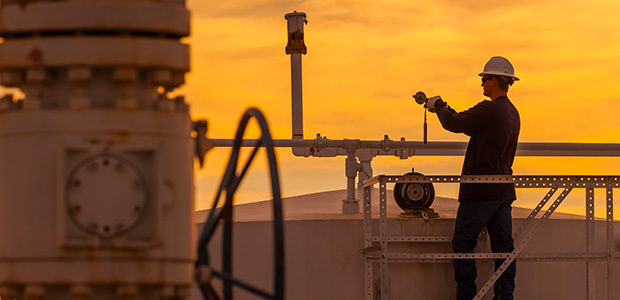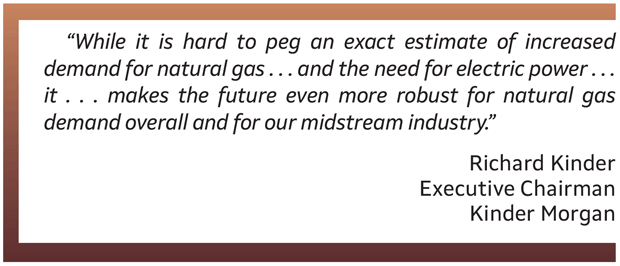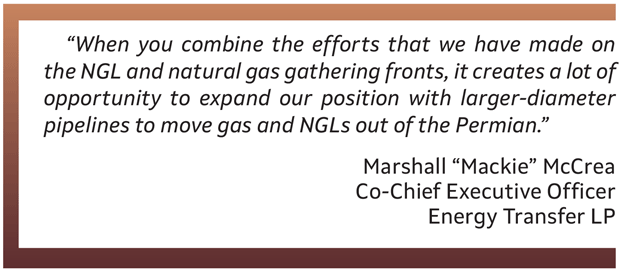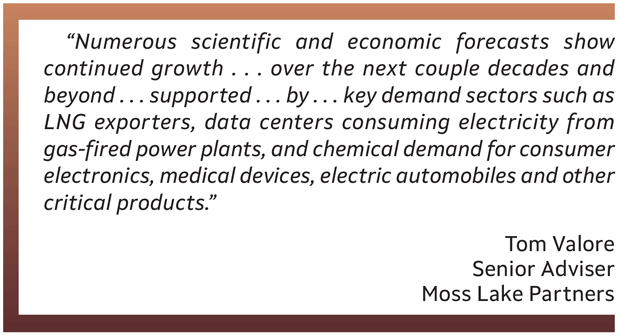
New Pipeline Projects Feed Growing Gas Demand, Alleviate Takeaway Constraints
By Danny Boyd
New pipelines with an aggregate capacity to transport 6 billion cubic a day of natural gas entered service in the United States last year, and more new projects are coming on line this year as the industry continues to build out natural gas infrastructure to meet current and future demand.
With 10 Bcf/d of new liquified natural gas export capacity expected during the next five years—growing total U.S. LNG export capacity to more than 22 Bcf/d—and new gas-fired electricity baseload being added every day to supply rapidly expanding consumption from data centers, experts project that some 20 Bcf/d of additional gas demand by the end of the decade.
Moving that much more gas every day from the producing well site though the gathering, processing, transportation, storage and distribution network to the ultimate point of consumption seems like a daunting task, but help is on the way.
A case in point is the Matterhorn Express, which is starting up this quarter and is expected to lessen takeaway constraints in the Permian Basin’s associated-gas-rich resource plays. Matterhorn has he capacity to carry up to 2.5 Bcf/d, an equivalent volume of gas to supply some 1.5 million homes, according to operator WhiteWater Midstream, whose partners for the project include EnLink Midstream, Devon Energy and MPLX, a master limited partnership formed by Marathon Petroleum.
The 580-mile pipeline stretches from the Waha Hub to the Katy Hub just west of Houston. It includes an extension from Martin County, Tx., in the northern Midland Basin to the mainline in the south.
In Appalachia, meanwhile, the eagerly anticipated Mountain Valley Pipeline became operational this summer, and Marcellus producers hope that it will help alleviate constraints that have created a pricing disadvantage because of basis price discounts to Henry Hub. In addition to MVP, projects are underway to connect more gathering systems to lines transporting gas to hubs in the Mid-Continent and Gulf Coast, where Appalachian gas can access premium markets.
More than 4 Bcf/d of intrastate pipeline developments this year are targeting Haynesville supply in Louisiana, according to Wood Mackenzie, and projects also are planned to carry more gas out of the Williston and Powder River basins.
Exponential Growth
With the anticipated growth in gas demand for domestic and foreign markets, Energy Transfer LP continues to build on a position that moves natural gas and natural gas liquids around the United States and to its NGL export terminals at Marcus Hook, Pa., and Nederland, Tx. The need for more infrastructure to process, move and ship gas will only grow, insists Co-Chief Executive Officer Marshall “Mackie” McCrea.
“We keep hearing about this transition away from fossil fuels, but in fact, we are seeing significant demand for pipeline infrastructure and export infrastructure from the exponential growth in the demand for natural gas liquids and natural gas globally,” he says.
Through organic growth and acquisitions, the Dallas-based company is expanding service in the Permian, where projects are expected to boost overall processing capacity to 5 Bcf/d within two years. With the July 15 closing of its acquisition of WTG Midstream, Energy Transfer added 6,000 miles of gas gathering pipelines and eight processing plants with 1.3 Bcf/d of aggregate capacity in the Midland Basin.
Two additional Midland Basin plants are under construction to expand coverage for operators in northeastern Midland County, Howard County, Tx., and in counties south of the city of Midland, McCrea details.
Plant optimizations in the Delaware Basin will add 50 million cubic feet a day of capacity at each of four plants. Utilizing an idled plant that is being relocated, the company recently made a financial investment decision on the Badger Plant along the Texas-New Mexico state line that will provide an incremental 200 MMcf/d. McCrae points out that expansion projects are backed by long-term, dedicated acreage and production across the Permian.
With about $3 billion in growth capital companywide this year, Energy Transfer is debottlenecking and upgrading Permian NGL pipelines.
“When you combine the efforts that we have made on the NGL and natural gas gathering fronts, it creates a lot of opportunity to expand our position with larger-diameter pipelines to move gas and NGLs out of the Permian,” McCrea says.
One possibility is the company’s Warrior pipeline, which is on the drawing board to transport gas from the Waha Hub in Pecos County, Tx., 260 miles east to 36- and 42-inch Gulf Coast and East Texas interconnects south of the Dallas-Fort Worth metroplex. The company is working to add commitments, and McCrea reports that a financial investment decision could come by the end of this year.
Additional Expansions
Elsewhere, additional capabilities from a backhaul pipeline on the company’s 2,400-mile Trunkline Gas System doubles the capacity to move gas from north to south, he says.
Also, new treating capacity in the Haynesville Shale is in the works this year as Energy Transfer evaluates the next phase of a potential capacity expansion of its Gulf Run Pipeline to carry gas from northern Louisiana to the coast. Beginning in January 2025, the 42-inch Zone 2 segment extending from Westdale 135 miles south to Starks near Lake Charles, La., will be fully subscribed with 1.65 Bcf/d of capacity.
Already, the company’s national system can carry gas on intrastate and interstate pipelines to power plants, industrial users, and its own NGL export terminals.
“Our processing and pipeline projects complement assets from five major transactions over four years,” says Co-CEO Thomas Long. He adds that Energy Transfer remains bullish that the consolidation trend will continue.
“Consolidation is good for us because we serve customers from the wellhead to water,” he says.
The merger in late 2023 with Crestwood Equity Partners LP included water, oil and gas midstream in the Williston Basin and an entry into the Powder River.
Building extensive takeaway for processed gas or NGLs is costly, but Energy Transfer and producers will benefit from announced plans by Kinder Morgan to reverse the Double H crude pipeline to carry NGLs from the Williston Basin to the Gulf Coast.
“We expect to see some of those NGL barrels end up going all the way from the Bakken to our fractionation units at Mont Belvieu, Tx.,” McCrae remarks.
Significant Demand Growth
Kinder Morgan’s $150 million Double H crude-to-NGLs conversion is expected to be in service in the first quarter of 2026, says company President Tom Martin. “Future phases can provide incremental capacity including in support of volumes out of the Powder River Basin,” he said during a July earnings call.
In the meantime, the Houston company, which has 67,000 miles of pipeline that transports roughly 40% of natural gas in the United States, continues to expand gas transportation capacity elsewhere and consider opportunities amid expectations of surging gas demand, it reports.
Not counting the need for additional supply at more LNG export terminals, gas demand will get a big boost from U.S. utility companies’ plans to add 133 new gas plants, partly to supply power at a growing number of artificial intelligence-driven data centers, says Kinder Morgan Executive Chairman Richard Kinder.
“While it is hard to peg an exact estimate of increased demand for natural gas as a result of all of this growth and the need for electric power, we believe it will be significant and makes the future even more robust for natural gas demand overall and for our midstream industry,” he says.
Kinder Morgan is currently in commercial discussions on more than 5 Bcf/d of opportunities related to power demand, including 1.6 Bcf/d related to data center demand, says Chief Executive Officer Kimberly Dang.
“Certainly not all these projects will come to fruition, but that gives you a sense of the activity levels we are seeing and support for our belief that growth in natural gas between now and 2030 will be well in excess of 20 Bcf/d,” she states.
New Pipeline Projects
Kinder Morgan has multiple projects coming on line or set to soon enter service. In July, the first phase of a $670 million Evangeline Pass project was placed in service with the second phase expected to enter service next summer. The project expands capacity on the company’s Tennessee Gas Pipeline and Southern Natural Gas systems in Mississippi and Louisiana to deliver up to 2 Bcf/d of gas to Venture Global’s Plaquemines LNG facility, according to a company overview of projects.
Expected to be in service in late 2028, an ongoing $3 billion expansion is designed to increase Southern Natural Gas pipeline’s South Line by 1.2 Bcf/f through looping and more compression on SNG and the Elba Express line to help meet more power generation and local distribution company demand in the Southeast.
In early July, the company says it executed definitive agreements for the go-ahead on the $263 million Altamont Green River Pipeline to relieve production constraints in the Uinta Basin. The pipeline will include 43 miles of 20-inch line and compression to transport up to 150 MMcf/d to the Western Chipeta processing plant. Temporary facilities are being built to accommodate immediate takeaway until the new pipeline’s expected commissioning in mid-2025.
Construction is also underway on a $94 million expansion of the Tejas Pipeline extending from South Texas to Houston through additional compression to boost gas deliveries by 350 MMcf/d. The project is expected to be completed by the first quarter of next year.
In November, Kinder Morgan says it expects to activate more lean gas treating and transportation in the Eagle Ford’s Webb County, Tx., with a $168 million expansion of the Texas Pipeline system. The expansion project, which is supported by long-term contracts, is designed to deliver up to 400 MMcf/d into the company’s Texas Intrastate network.
Last year, the company bought the South Texas Midstream pipeline system and its large-diameter, high-pressure pipelines that connect the Eagle Ford to Mexico and Gulf Coast markets.
DeLa Express Pipeline
Amid growing and anticipated demand, DeLa Express LLC, a subsidiary of Moss Lake Partners, is sponsoring the proposed DeLa Express project, a 645-mile, 42-inch mainline pipeline with associated lateral pipelines capable of transporting 2 Bcf/d of liquids-rich natural gas from the Permian Basin to high-demand consumer markets in the Lake Charles area.
In February 2025, an application is expected to be submitted to the Federal Energy Regulatory Commission, according to project details provided by Moss Lake. A FERC certificate and notice to proceed is anticipated by the second quarter of 2026. Construction would begin shortly thereafter, with the line projected to go in service by mid-2028, according to Tom Valore, senior adviser at Moss Lake Partners.
The private Houston company, which focuses on midstream infrastructure and sourcing, transporting, storing and marketing commodities, will have to acquire more than 700 miles of rights of way to complete the multibillion-dollar project.
The proposed line would include supply laterals, processing and compression, Valore notes. Three dew-point control facilities with corresponding pipeline laterals would feed the main line. It would include multiple compressor stations to transport the gas to Calcasieu Parish in southwestern Louisiana.
“Numerous scientific and economic forecasts show continued growth in natural gas and liquids production in the Permian Basin over the next couple decades and beyond,” observes Valore. “This growth trajectory is supported not only by major producers’ forecasts, but also by key demand sectors such as LNG exporters, data centers consuming electricity from gas-fired power plants, and chemical demand for consumer electronics, medical devices, electric automobiles and other critical products.”
“NGL consumer projections similarly project growth, particularly overseas where new European and Asia Pacific gas and chemical demand, driven by new industrial plants and certain geopolitical circumstances, continue to boost global demand for U.S. natural gas and liquids exports,” he adds.
The company is in negotiations for supply with major and independent producers, and also is in negotiations with major global consumers of ethane and LPG (propane and butane) for anticipated supplies from its planned Hackberry NGL export terminal in Cameron Parish, La., reports Senior Advisor Jay Gulley.
He says construction at Hackberry would begin in early to mid-2026 with an expected in-service date of mid-2028. Export capacity would be 315,000 barrels a day, which can be expanded to 450,000 bbl/d.
“We have strong interest from many parties that view our Hackberry/Calcasieu Ship Channel supply as a geographically advantaged and economically competitive solution for rapidly growing U.S. NGL exports,” says Gulley. “Many of these parties, including major global consumers of ethane and LPG, are currently in long-term contract negotiations with Moss Lake Partners.
For other great articles about exploration, drilling, completions and production, subscribe to The American Oil & Gas Reporter and bookmark www.aogr.com.


















